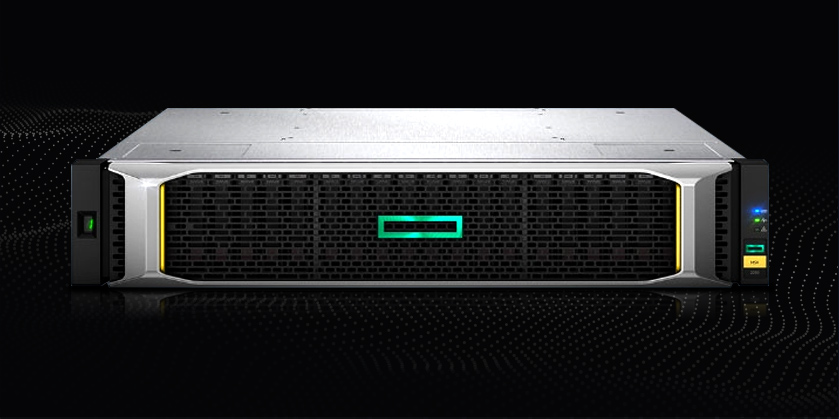HPE Flash Storage Review: MSA 2050 and 2052

Most small- and medium-sized businesses face the same challenge as enterprises: how to find the right storage architecture that will grow with the company, be flexible enough for future workloads and is able to maximize productivity for the entire operation.
As a critical part of the overall implementation of technology, storage solutions must offer effective management of all your data and IT needs. On top of that, it must also be affordable and easy to use — something that is particularly important for smaller companies that often have limited IT experience and/or a small IT department.
For the past eight years, HPE’s Modular Smart Array (MSA) has been the
best-selling entry-level SAN array, with more than half a million units shipped in less than a decade. As a flash-enabled array that is surprisingly easy on the budget, it provides solutions that allow for growth and flexibility as your small business’s storage capacity changes.
The introduction of the fifth generation of MSA architecture brings more features, better performance and options that would be right at home in enterprise-level environments — but are available at entry-level pricing.
Who Can Benefit from the MSA 2050/2052?
Since storage needs can vary from one company to the next, not all storage solutions will work in every environment. However, the
HPE MSA 2050 and MSA 2052 are designed to meet the needs of a variety of business environments. In particular, these models are a good fit for:
- Small business users in need of an entry-level consolidation solution that provides easy-to-use storage at an affordable price
- Remote or branch office locations of an SMB looking for a cost-effective solution that can be duplicated at multiple sites
- Mid-size businesses or enterprises looking for supplemental storage, such as for a specific department; the MSA 2050 and MSA 2052 can provide a supplement to an existing mid-size or enterprise level storage array
What makes either of these models such an excellent storage choice? For starters, the MSA user interface is designed to be simple, straightforward and easy to use — even if you don’t have any experience using storage and only have a limited IT department. The intuitive dashboard also helps simplify the process and make it easy to monitor your usage.
One of the primary differentiators between storage solutions is the type of software each one operates on. The MSA software is called Advanced Data Services and has such features as thin provisioning, redirect-on-write, wide striping, SSD read cache and automated performance tiering.
What’s So Great About Them?
There is a
lot more to love about these performance-driven storage arrays, and as mentioned earlier, one of the biggest selling features is their affordability. With other storage arrays, real-time tiering typically comes at a steep price rather than coming as a standard feature. The automated tiering feature automatically moves data from one set of disks to a more appropriate set of disks based on data access patterns, which means frequently accessed data will be kept on better performance/lower capacity disks while infrequently accessed data is stored on disks with lower performance and greater capacity.
All MSA models come with active/active (or dual active) controllers with speed increases that are made possible by a CPU upgrade. A dual active controller is a storage array configuration in which two (or more) storage controllers work together to process inputs/outputs. The upgrade can double their cache memory from 4GB to 8GB per controller, and the 2050/2052 models have made an incredible leap over the MSA 2040 by offering more than twice the random input/output operations per second (IOPS). The fifth generation MSA is capable of executing more than 200,000 IOPS, meaning you can optimize workloads in a way that previously could not be done at this price point.
Expanded data protection has been added to the MSA 2050/2052, and since each controller uses a super-capacitor and CompactFlash card, the cache contents are protected from power failures.
While the two models are similar in many ways, they do have some differences; namely, while the MSA 2052 is a hybrid flash array, the 2050 is hybrid flash-ready. However, it’s designed for expansion, so that could be added in the future if needed.
Which MSA Is Right for Your Small Business?
HPE’s Gen5 MSA 2050 and 2052 deliver a surprising amount of storage at a price that’s easy on small businesses. The set of solutions they offer — such as virtualization, SQL, Microsoft Exchange and more — are designed to meet the needs of the small business operator.
With its updated hardware, this latest iteration of the HPE MSA delivers significantly improved performance and a more versatile range of features. This is the storage array that has both the affordability and flexibility needed to help your business grow into the future.
|
Tech Specs
|
HPE MSA 2050/2052
|
|
Chassis
|
2U Rackmount
|
|
Drives and Capacity
|
Drives: Up to 12 3.5” and up to 24 2.5” SAS, SAS SSD, or Nearline SAS hard drives
Maximum Capacity (Per Enclosure): 144TB
Maximum Throughput: 12Gb/s
Expansion Capabilities: Daisy-chain up 7 disk enclosures (either LFF and/or SFF). The array can grow incrementally from a few drives to 96 LFF or 192 SFF drives
|
|
Host Connectivity
|
MSA 2050 storage controller will support up to four 8Gb/16Gb FC, 1GbE/10GbE iSCSI, and/or a 12Gb/s SAS port with 16GB cache per controller
|
|
Enclosure Management
|
I/O Modules: Dual (2) Redundant Quad-Port 8Gb/16Gb FC, 1GbE/10GbE iSCSI, and/or a 12Gb/s SAS port Controllers with 16GB Cache
RAID Levels: 0, 1, 5, 6, 10
|
|
Software Features
|
Thin Technologies: Thin Provisioning, Space Reclamation, Thin Rebuild
Quality of Service: Virtual Tier Affinity
Tiering: Performance Tier, Standard Tier, Archive Tier
Replication: Snapshots (512), Volume Copy, Remote Snaps
|
|
Power Supply
|
Dual (2) redundant power supplies standard
|
Recommended Reading
|